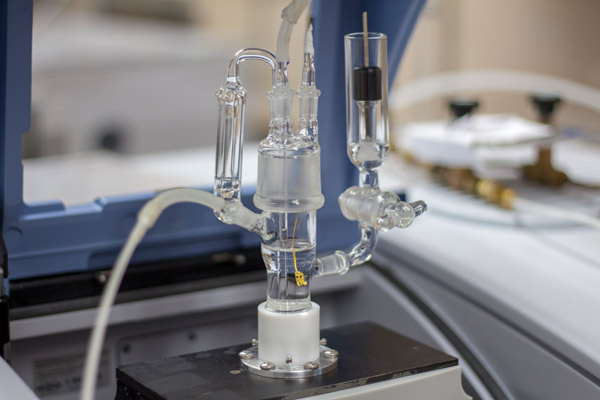
Students partner with professor on chemistry startup
A tool developed for specialized research in the College of Arts and Science is being adopted by scientists around the world through a new venture by its inventors
By Chris Putnam
A tool developed for specialized research in the College of Arts and Science is being adopted by scientists around the world through a new commercial venture by its inventors in the Department of Chemistry.
In February, Professor Ian Burgess and PhD candidates Jessica Sigrist and Tyler Morhart co-founded Jackfish SEC Manufacturing to bring to market a product called a spectroelectrochemical (SEC) cell.
“All that is in layman’s terms is a piece of elaborate glassware and machined pieces which allow scientists to do experiments that otherwise they wouldn’t be able to do,” said Burgess.
SEC cells are needed for the research technique known as ATR-SEIRAS, a non-destructive way of studying chemical processes on the surfaces of metals using light. It is a valuable method in the field of electrochemistry, with applications in consumer electronics, next-generation energy solutions, medical diagnostics and other areas.
But until recently, the barrier to entry of using ATR-SEIRAS was daunting. Building a working cell requires such specialized knowledge that no manufacturer of scientific instruments offered an off-the-shelf solution. Researchers such as those in Burgess’s group had to construct their own cells based on descriptions in scientific papers—a challenging prospect even for an expert.
“If you were following the literature, you would have to do what we did and spend basically years ironing out all kinds of different bugs and issues … to finally get to the point that you can have an experiment where you can say, ‘We’re confident in this. This works,’” said Morhart.
The University of Saskatchewan team had the advantage of access to the Department of Chemistry’s on-site scientific glassblower Rick Elvin and skilled machinists in the Physics Machine Shop, who worked closely with the researchers as they refined their SEC cell over several years.

With the latest revision of the device, they knew they had something special: a simple and robust cell that worked consistently. But the team didn’t seriously consider the commercial possibilities until Burgess had a chance meeting in British Columbia with Jenni Briggs, marketing and applications engineer for American scientific instrument manufacturer PIKE Technologies.
“I told her that we had made a spectroelectrochemical cell that mounts directly to their accessory, and she was super excited,” said Burgess.
“I said, ‘Maybe you should think about making them,’” Briggs recalled.
It was the start of a “good synergistic collaboration,” said Briggs. “We had the distribution, they had the knowhow, and they had a really nice cell with some really innovative features to it.”
Burgess, Morhart and Sigrist decided to take the leap as equal partners in a technology startup, but they needed help.
“We approached this as scientists. We had no idea how to run a business,” said Sigrist.
They found a wellspring of advice next door in Associate Professor Stephen Foley, who recently launched a company to commercialize his research team’s gold recycling process.
The university’s Innovation Enterprise office offered further support, along with the entrepreneurial minds in the Edwards School of Business. Lee Swanson, associate professor of management and marketing, challenged a class of his MBA students to develop potential business plans for Jackfish SEC.
“It was a really good experience,” said Sigrist. “They peppered me with questions, and in the end, they came up with these ideas for different models that we could use to take our business in whatever direction we wanted to take it.”
Jackfish SEC is now actively producing SEC cells for PIKE Technologies. The cells are manufactured in small batches on campus through contracts with the Physics Machine Shop and the glassblowing laboratory.
The first cells have been sold to researchers in Asia, Europe and the United States, and the ready-to-go product has generated a lot of interest from scientists who want to spend more time doing research and less time tinkering with equipment.
“From a science standpoint, it helps to accelerate their research,” said Briggs.


